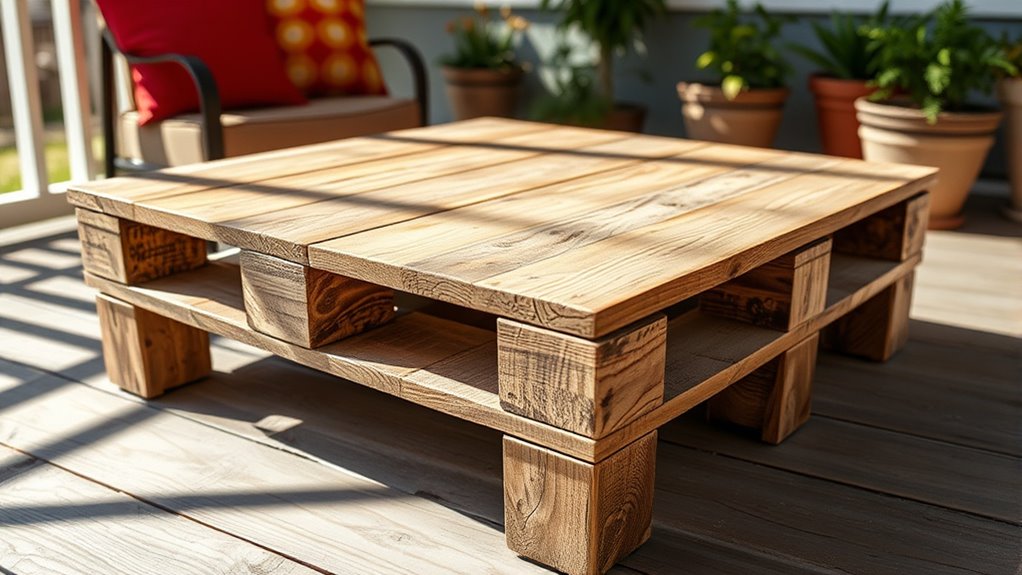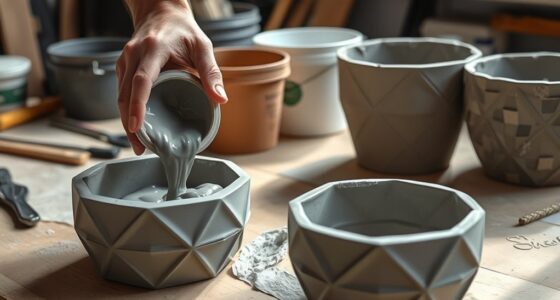To build a pallet coffee table under $25, start by sourcing free or inexpensive pallets locally or online, focusing on sturdy, clean pieces. Then, measure, cut, and assemble the wood using basic tools like a saw and screws, ensuring a stable frame. Sand all surfaces smoothly and finish with paint or stain to match your decor. Adding simple touches like handles can elevate the look. Keep exploring, and you’ll discover more tips to create a stylish, budget-friendly table.
Key Takeaways
- Source free or inexpensive pallets locally or online, ensuring they are sturdy, safe, and free of damage or chemicals.
- Use basic, affordable fasteners like nails or screws, and repurpose materials to stay within the $25 budget.
- Measure, cut, and assemble the pallets carefully, prioritizing simple designs to minimize material and tool costs.
- Sand and finish the surface with inexpensive paint or stain to enhance appearance without exceeding budget.
- Add DIY decorative touches or functional features using low-cost supplies to personalize your table affordably.
Gathering Materials and Tools
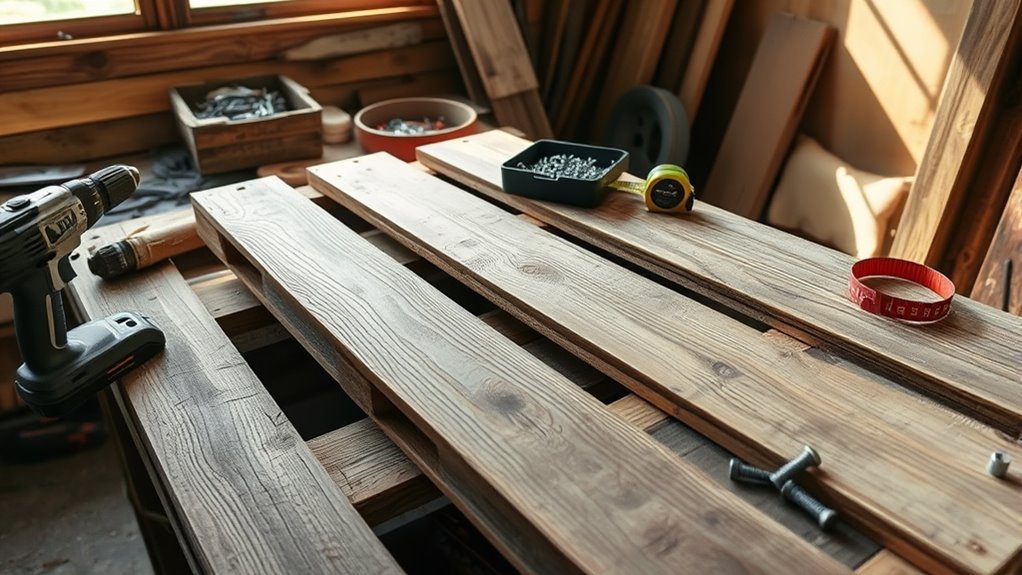
Before you begin building your pallet coffee table, gather all the necessary materials and tools. You’ll need basic supplies like pallets, nails or screws, a hammer, screwdriver, and measuring tape. For the upholstery, consider simple upholstery techniques to create a comfy top or cushion if you want added comfort. When choosing paint color choices, pick a shade that complements your space—neutral tones work well for versatility, while bold colors add character. You might also want sandpaper for smoothing rough edges and brushes or rollers for painting. Ensuring you have everything ready before starting saves time and keeps the project smooth. Double-check your supplies to avoid interruptions, and plan your color scheme and upholstery style to match your decor.
Selecting and Preparing Pallets
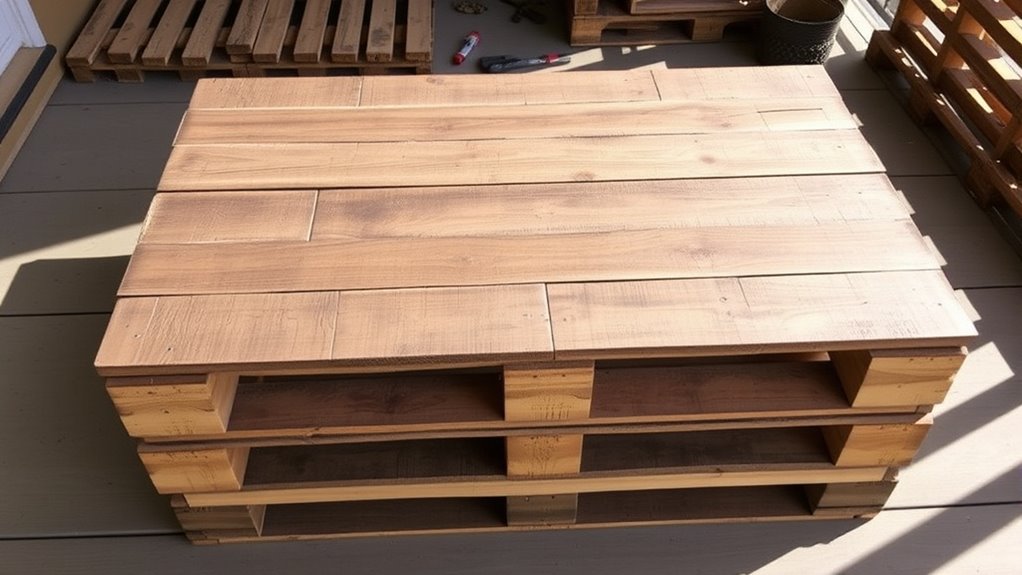
Start by choosing pallets that are sturdy, clean, and free of chemicals or damage. Once you have your pallets, disassemble and sand them thoroughly to smooth out rough edges and surfaces. You can also look for pallets that meet safety standards to ensure durability and safety. Finally, double-check that your pallets are stable and safe to use, making any necessary repairs before building.
Choosing the Right Pallets
Choosing the right pallets is essential for building a sturdy and attractive coffee table, so it’s important to inspect each one carefully. Look for pallets with good pallet durability, meaning they show no signs of rot, mold, or damage. Strong, well-maintained pallets ensure your table stays stable over time. Additionally, consider the environmental impact of your pallets; opt for reclaimed or eco-friendly sources to reduce waste and support sustainability. Avoid pallets treated with chemicals or pesticides, as these can be harmful and difficult to work with. Check for labels indicating safe treatment methods, like heat-treated pallets. Selecting pallets that meet these criteria helps you create a durable, eco-conscious piece that enhances your space without compromising safety or quality.
Disassembling and Sanding
Disassembling and sanding your pallets are vital steps to prepare them for your coffee table project. Proper pallet restoration begins with carefully disassembling the pallets to avoid damage. Use a crowbar or hammer to pry apart the boards gently. Once disassembled, inspect each piece for nails, staples,, or splinters, removing them carefully. Sanding techniques are imperative to achieve a smooth surface and remove rough spots, splinters, or old finish. Start with coarse grit sandpaper to strip away rough areas, then switch to finer grits for a polished look. Focus on all surfaces, including edges and corners. Proper sanding not only enhances the appearance but also guarantees safety by eliminating splinters. Taking your time with disassembly and sanding will lead to a professional-looking, durable coffee table. Additionally, understanding proper Sanding techniques helps ensure an even finish and long-lasting results.
Ensuring Stability and Safety
To guarantee your pallet coffee table is both stable and safe, you need to carefully select pallets that are structurally sound and free from damage. Check for cracks, splinters, or signs of rot, as these compromise pallet durability. Ensure the pallets can handle the weight capacity you need; heavier items or added weight require sturdier pallets. Choosing pallets made from durable wood, like hardwood, increases stability. Before proceeding, test each pallet’s strength by gently pressing on different areas. Avoid pallets with broken slats or weak joints. Properly inspecting and selecting pallets based on their structural integrity guarantees your table will be safe for everyday use. Additionally, considering home cinema technologies can inspire creative design ideas for integrating entertainment features into your space. This careful preparation creates a solid foundation, preventing accidents and ensuring your project’s longevity.
Measuring and Cutting the Wood
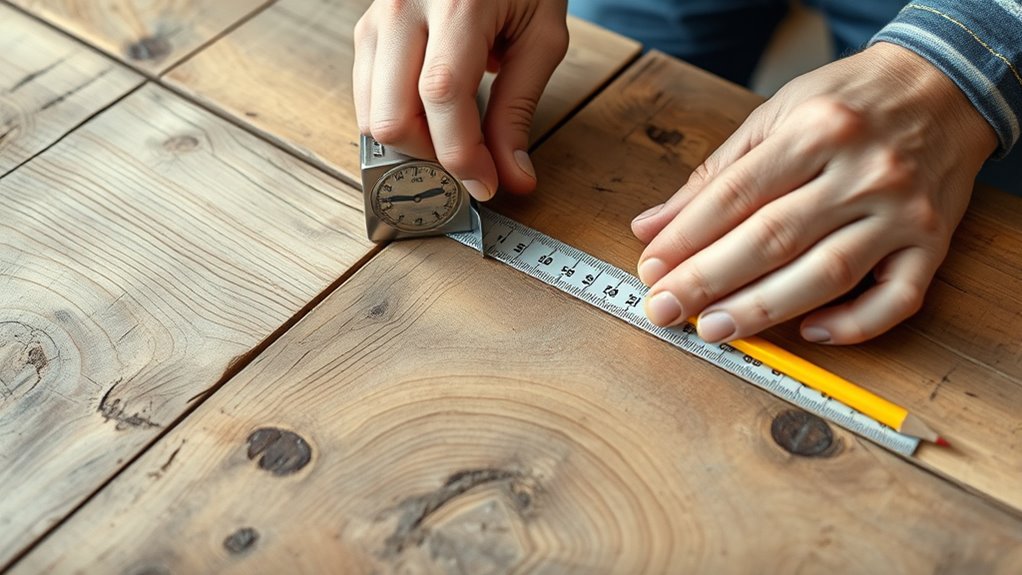
Start by choosing the right tools to guarantee clean, accurate cuts. Measure each piece carefully to match your plan and avoid mistakes. Then, cut precisely along your marked lines to get the perfect fit for your table. Additionally, ensure your workspace is organized to facilitate precise measurement and cutting processes.
Select Appropriate Tools
Before you begin cutting and measuring, make certain to select the right tools to guarantee accuracy and safety. Power tools like a circular saw or jigsaw will make straight cuts easier and quicker, but confirm you’re comfortable using them. A tape measure is essential for precise measurements, while a carpenter’s square helps keep cuts square. Always wear safety gear—goggles to protect your eyes and gloves to shield your hands. Using the proper tools prevents mistakes and reduces the risk of injury. Double-check that your power tools are in good condition before starting. Having the right equipment ready ensures your project stays on track, saves time, and results in a clean, professional look for your pallet coffee table. Additionally, understanding sound vibrations can enhance your focus and mindfulness during the project.
Measure Carefully
Accurate measuring and careful cutting are essential steps in building your pallet coffee table, as they guarantee all pieces fit together perfectly. When working with pallet recycling, each wood piece can vary in size, so double-check measurements before cutting. Proper measurement ensures your furniture design looks professional and functions well. Use a reliable tape measure and mark your cuts clearly, accounting for any overhangs or desired dimensions. Take your time to measure twice, cut once—mistakes can lead to wasted materials or unstable joints. Remember, precise measuring minimizes errors and helps maximize your budget. By paying close attention during this stage, you’ll create a sturdy, attractive table that showcases the beauty of recycled pallets and your craftsmanship. Additionally, considering projector specifications can help you plan the space and size of your table for optimal viewing.
Cut Precisely
Ensuring you cut your wood precisely is vital to building a stable and attractive pallet coffee table. Accurate measurements prevent gaps, wobbling, and weak joints, making your DIY woodworking project safer and more enjoyable. Use a sharp saw and a sturdy guide to achieve clean, straight cuts. Remember, pallet safety is essential—always wear safety gear and work in a well-ventilated area. Double-check your measurements before cutting to avoid mistakes that could ruin your project or cause injury. Take your time to measure twice and cut once; rushing can lead to uneven pieces. Precise cuts ensure your table is sturdy and visually appealing, giving your space a professional touch. Confidence in your cuts makes the entire DIY process smoother and more rewarding. Utilizing proper measurement techniques can further enhance the accuracy and quality of your build.
Assembling the Table Frame

To assemble the table frame, start by laying out the pallet slats and side pieces according to your design. Consider your pallet sourcing options to stay within your budget—used pallets from local stores or online sources often save money. Once arranged, join the pieces using nails or screws, ensuring the frame is sturdy. Keep in mind that your budget considerations may influence the type of fasteners you use. Use the table below to understand the importance of sourcing and planning:
| Pallet Sourcing | Budget Considerations |
|---|---|
| Find free or inexpensive | Choose cost-effective |
| pallets locally or online | fasteners and materials |
| Ensure quality for durability | Balance price with durability |
| Reuse or repurpose pallets | Maximize value from each item |
Additionally, participating in hackathons can inspire innovative approaches to your DIY projects and help you discover new sourcing or building techniques.
Sanding and Finishing Touches
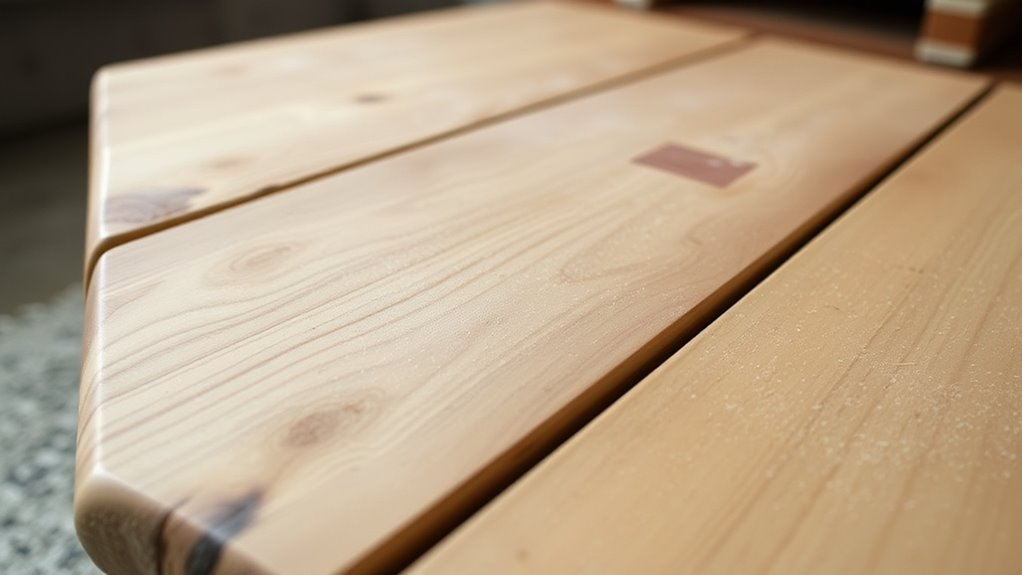
Once you’ve assembled the table frame, the next step is to sand all surfaces thoroughly. Focus on smoothing rough edges and surfaces to create a polished look. Use fine-grit sandpaper to gently remove splinters and imperfections, especially along the edges, for a sleek finish. Proper sanding enhances the overall appearance and prepares the surface for varnish application. When applying varnish, guarantee even coverage to highlight the natural beauty of the wood. Pay special attention to edge smoothing, so the finish looks seamless and professional. Take your time—smooth surfaces and well-applied varnish will make your pallet coffee table stand out and last longer. Enjoy the process, knowing your efforts result in a beautiful, handcrafted piece.
Adding Optional Features and Customizations
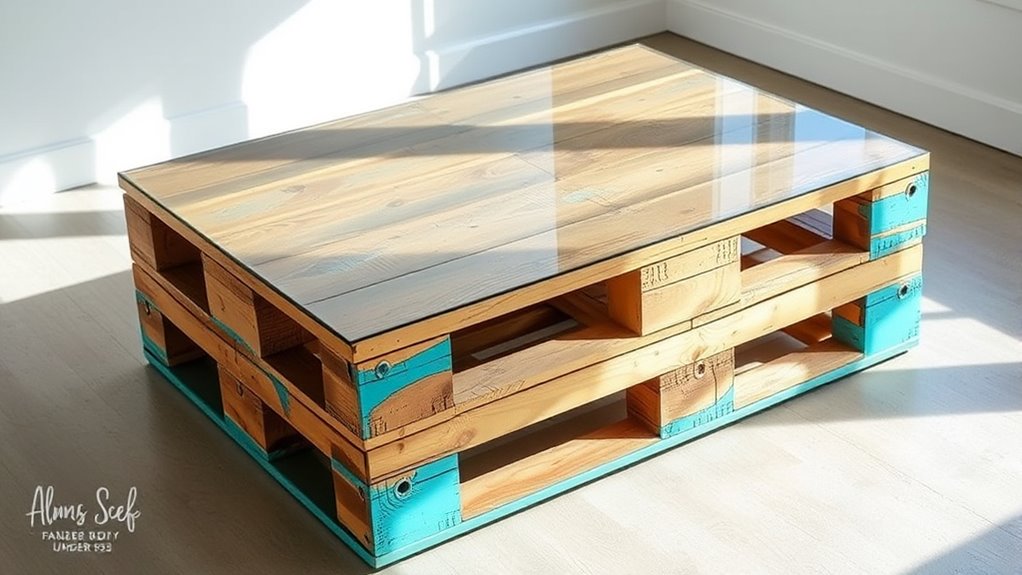
Adding optional features and customizations allows you to personalize your pallet coffee table and make it uniquely yours. You can enhance its look with decorative accents like metal handles, decorative nails, or stencils that add character. Custom paint options are a simple way to match your table to your room’s style—consider bold colors, distressed finishes, or even two-tone designs. If you want a rustic feel, leave some areas unfinished or apply a weathered stain. Adding small touches like a tray top, storage baskets, or a chalkboard section can also boost functionality. These customizations help you craft a piece that reflects your personality and complements your space, all while staying within your budget. Incorporating personal growth techniques like mindfulness into your design process can make the project more fulfilling.
Final Assembly and Placement

After assembling all the components of your pallet coffee table, carefully check that everything is securely fastened and level. Proper placement enhances both function and style, so consider your furniture arrangement carefully. Once in position, add decorative accents like cozy throws, candles, or plants to make it inviting. Ensure the table is centered in your space for balanced visual appeal. Think about how the table interacts with other furniture pieces to create a cohesive look. Take a step back and evaluate if the height and placement suit your needs. Adjust if necessary to guarantee comfort and practicality. When satisfied, enjoy your budget-friendly creation as a stylish focal point that reflects your personality and creativity. Your custom pallet table is now ready to impress. Portable restroom solutions can also offer unique opportunities for outdoor gatherings, making your space both functional and stylish.
Frequently Asked Questions
How Can I Ensure the Pallet Wood Is Safe and Non-Toxic?
To verify your pallet wood is safe and non-toxic, start by researching pallet wood treatment to avoid harmful chemicals. Look for pallets labeled as heat-treated, not chemically treated. Before using, sand thoroughly to remove splinters and surface contaminants. Seal the wood with non-toxic sealants to prevent any residual chemicals from leaching. This way, your coffee table will be both beautiful and safe for everyday use.
What Tools Are Essential for Beginners in Woodworking?
Did you know that 75% of woodworking accidents happen due to lack of proper tools or safety measures? As a beginner, you should focus on essential tools for your beginner tool kit, like a saw, hammer, and measuring tape. Prioritizing woodworking safety, choose beginner-friendly tools with safety features. These basics will help you learn confidently while minimizing risks, making your projects more enjoyable and safer.
How Do I Maintain the Table’s Stability Over Time?
To keep your table stable over time, focus on table leg reinforcement by securely attaching the legs and checking for looseness regularly. Use surface sealing techniques like applying a clear sealant or finish to protect the wood from moisture and wear. These steps help prevent warping and wobbling, ensuring your table remains sturdy and durable for years. Consistent maintenance and proper reinforcement are key to long-lasting stability.
Can I Customize the Table’S Height Easily?
You can easily customize the table’s height by adjusting the legs or adding spacers, making it simple to achieve your desired height. For flexible height adjustment, consider using adjustable legs or stacking blocks for customizable dimensions. This way, you can modify the table’s height over time without much effort, ensuring it fits your space and needs perfectly. It’s a straightforward process that enhances your table’s versatility and comfort.
What Are Budget-Friendly Alternatives to Sanding and Finishing?
Did you know that over 60% of DIY enthusiasts save money by using alternative finishing methods? To skip sanding and finishing, try DIY paint techniques like chalk paint or milk paint, which require minimal prep and add character. Reclaimed wood options also give your table a rustic look without extra costs. These budget-friendly choices help you create a stylish, personalized coffee table without breaking the bank.
Conclusion
And there you have it—your masterpiece of thrift and ingenuity, all for less than a fancy coffee drink. Who knew that turning pallets into a coffee table could be so satisfying (and budget-friendly)? Now, invite your friends over, proudly showcase your DIY skills, and watch them marvel at your “professional” craftsmanship. Just don’t forget to remind them you built it for $25—because nothing says “impressive” like a table you made yourself and barely broke the bank.
